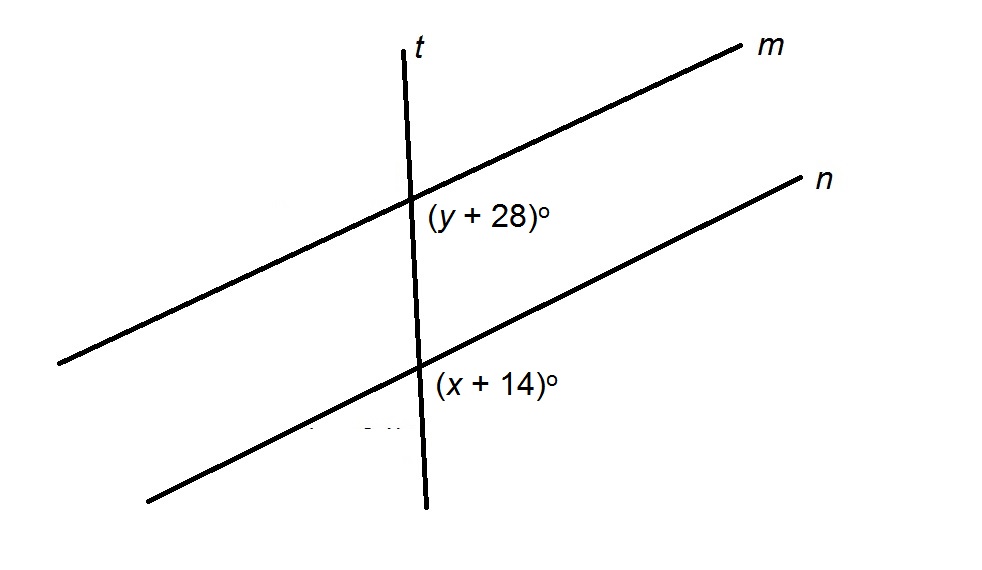All SSAT Upper Level Math Resources
Example Questions
Example Question #1 :Properties Of Parallel And Perpendicular Lines
Line P passes through the origin and point
Line Q passes through the origin and point
Line R passes through the origin and point
Line S passes through the origin and point
Which of these lines is parallel to the line of the equation
Line Q
Line R
Line P
Line S
None of the other responses is correct.
Line S
First, find the slope of the line of the equation
The slope of this line is
Find the slopes of all four lines by using the slope formula
using the other point.
Line P:
Line Q:
Line R:
Line S:
Line S has the desired slope and is the correct choice.
Example Question #2 :How To Find Whether Lines Are Parallel
You are given three lines as follows:
Line A includes points

Line B includes point


Line C includes the origin and point
Which lines are parallel?
Find the slope of all three lines using the slope formula
Line A:
Line B:
Line C:
Lines A and C have the same slope; Line B has a different slope. Only Lines A and C are parallel.
Example Question #421 :Geometry
Line A has equation
Line B has equation
Which statement is true of the two lines?
Write each statement in slope-intercept form:
Line A:
The slope is
Line B:
The slope is
The lines have differing slopes, so they are neither identical nor parallel. The product of the slopes is
Example Question #4 :How To Find Whether Lines Are Parallel

Figure NOT drawn to scale
In the above figure,

Angles of degree measures

Solving for
The angles of measures

Substituting for
Example Question #5 :How To Find Whether Lines Are Parallel

Figure NOT drawn to scale
In the above figure,


The two marked angles are same-side interior angles of two parallel lines formed by a transversal
Solve for
Example Question #6 :How To Find Whether Lines Are Parallel

Figure NOT drawn to scale
In the above figure,


The two marked angles are corresponding angles of two parallel lines formed by a transversal, so the angles are congruent. Therefore,
Solving for
Example Question #7 :How To Find Whether Lines Are Parallel

Figure NOT drawn to scale
In the above figure,

The two marked angles are same-side exterior angles of two parallel lines formed by a transversal
Example Question #1 :Properties Of Parallel And Perpendicular Lines
Three lines are drawn on the coordinate plane.
The green line has slope


The blue line has slope


The red line has slope


Which two lines are perpendicular to each other?
The blue line and the green line are perpendicular.
It cannot be determined from the information given.
No two of these lines are perpendicular.
The green line and the red line are perpendicular.
The blue line and the red line are perpendicular.
The blue line and the red line are perpendicular.
To demonstrate two perpendicular lines, multiply their slopes; if their product is

The products of these lines are given here.
Blue and green lines:
Red and green lines:
Blue and red lines:
It is the blue and red lines that are perpendicular.
We can also see that their slopes are negative reciprocals, indicating perpendicular lines.
Example Question #1 :How To Find Whether Lines Are Perpendicular
Two perpendicular lines intersect at point

Insufficient information is given to answer the question.
The slopes of two perpendicular lines are the opposites of each other's reciprocals.
To find the slope of the first line substitute
The slope of the first line is

Example Question #3 :Properties Of Parallel And Perpendicular Lines
Two perpendicular lines intersect at the origin; one line also passes through point
Insufficient information is given to solve the problem.
The slopes of two perpendicular lines are the opposites of each other's reciprocals.
To find the slope of the first line, substitute
The slope of the first line is

Certified Tutor
Certified Tutor
All SSAT Upper Level Math Resources




















































































